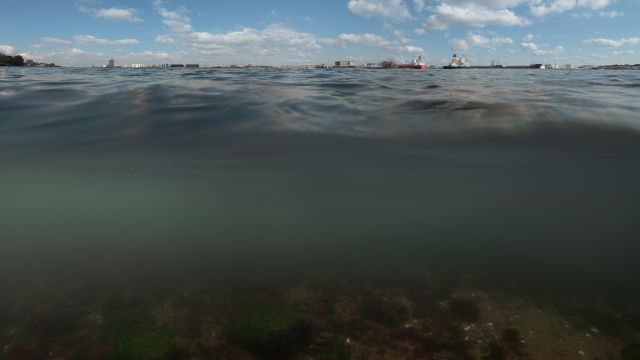
The eighteenth edition of No More Potlucks features an eclectic group of writers and artists, including Montreal’s Isabelle Hayeur, whose photography graces the publication’s front page. While Hayeur is perhaps best known for her large-scale photographs and seamless digital manipulation of fabricated landscapes, her artistic practice extends into video, as well as site-specific installations. One of Hayeur’s most hypnotic explorations of ephemerality is Fire with Fire, a three-channel video installation set up in a building in Vancouver’s Downtown Eastside. A precursor to the Olympic gentrification of the neighbourhood, Hayeur’s piece created the illusion of a three-storey building being ablaze, engulfed in a never-ending cycle of flames. Hayeur’s current photo work, Underwolds, is an ongoing investigation of aquatic deserts. I spoke with the artist about Underworlds, upcoming projects, and the themes that permeate her work.
The image on NMP #18 is from your Underworlds series, an ongoing project you began in 2008. Are there new bodies of water you want to photograph?
I plan to return to Staten Island to document the Witte's Marine Salvage once more. This site is fascinating; it’s a navy graveyard near the New York harbour, in Arthur Kill. I’ve done several photographs depicting the waters and shipwrecks there, and now I want to shoot a video. I’d like to document the south of the Mississippi River and the Gulf of Mexico. I’m especially interested in the areas that the BP oil spill affected.
Contemporary pop culture is rife with images of post-apocalyptic landscapes. Yet, your work illustrates that this sort of profound devastation is already with us, be it through abject poverty or the ruin of the natural world via urban sprawl. How do you read these fictionalized renditions of something you’ve documented firsthand?
I was born in ‘69 in suburbia. I grew up in the seventies reading science fiction and watching dystopian movies. The last scene of Planet of the Apes, where you see the Statue of Liberty half-buried in sand, always fascinated me. I also loved 2001, Logan's Run, Thx 1138, Soylent Green, and Zardoz. Orwell’s 1984 really impressed me. At the time, overpopulation and pollution were subjects we were discussing at home. We sensed that these dystopic stories were depicting a world, a “no man’s land,” that would soon come. Now, I feel like we live in this post-apocalyptic landscape; more and more, reality and fiction are entwined. Yet, we do so little to transform our ways of living. My work is part of the ongoing discourse that tries to bring awareness of the need for change.
Video still from Hayeur’s Private Views.
When creating site-specific or ephemeral work, how does your relationship to the piece change once all that’s left is documentation?
Creating site-specific installations is probably my preferred experience in art. It’s challenging, and you have a special relationship with your public because the work isn’t in a gallery or museum, so people who aren’t familiar with art see your work. The artwork only lasts for about a month, and it’s usually a very intense experience. I pay special attention to the important role of documentation.
Are you able to speak a bit about your upcoming video installation Innerland?
Innerland will be a mediation on industrial architecture. It will take place in an industrial building in Omaha, in conjunction with the group show Placemakers presented at The Bemis Center for Contemporary Arts. The work should be on view for about three weeks in March 2012. While in Omaha for a residency at the Bemis Center last spring, I noticed an industrial building with a long outdoor alleyway ending in a tunnel space. I met with the owner of the building and asked for permission to create a temporary artwork there. The installation will create an illusory space, and it will play with the architecture. We’ll construct a large wall at the end of the tunnel, and I’ll be projecting video and audio that simulate an infinite tunnel. Like most old factories, the interior is relatively anonymous and impersonal. There’s very little in the room to trigger any associations. The emptiness becomes strangely present and takes on another dimension, a vertiginous depth. This absence is like a desert of the interior.

Infiltration. Photo: Isabelle Hayeur
Infiltration elicits a personal reaction, because when I was a child, my father took me sledding in the Meadowbrook golf course, and I haven’t seen the site for about two decades. How did you end up there, and what state is the land in now?
Little St-Pierre River and the William sewer always fascinated me. You can see them at the Pointe à Callière Museum. This river used to have its source in Lake Saint-Louis, and it followed the current path of the Lachine Canal before flowing into the Saint-Lawrence. It was gradually altered and then channelled underground in a sewer. However, an affluent subsists and flows through the Côte Saint-Luc–Montreal West neighbourhood. A friend of mine told me about the uncovered section of the river in the Meadowbrook golf course. Only a short part of the river remains today and it’s polluted. Last I heard, they were going to build condos on the land. The sad aspect of this story is that the real estate project uses the vestige of this river as a promotional tool; the water is presented as an interesting "natural feature." When the principle of utility ranks higher than other values, and the economy is king, we view territories simply as “resources,” and as sites to occupy or exploit.
No More Potlucks fundraiser at Meow Mix
Saturday, December 3 at 9:30 p.m.
Sala Rossa | 4848 St. Laurent
nomorepotlucks.org | isabelle-hayeur.com